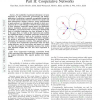Free Online Productivity Tools
i2Speak
i2Symbol
i2OCR
iTex2Img
iWeb2Print
iWeb2Shot
i2Type
iPdf2Split
iPdf2Merge
i2Bopomofo
i2Arabic
i2Style
i2Image
i2PDF
iLatex2Rtf
Sci2ools
CORR
2010
Springer
2010
Springer
Fundamental Limits of Wideband Localization - Part II: Cooperative Networks
The availability of positional information is of great importance in many commercial, governmental, and military applications. Localization is commonly accomplished through the use of radio communication between mobile devices (agents) and fixed infrastructure (anchors). However, precise determination of agent positions is a challenging task, especially in harsh environments due to radio blockage or limited anchor deployment. In these situations, cooperation among agents can significantly improve localization accuracy and reduce localization outage probabilities. A general framework of analyzing the fundamental limits of wideband localization has been developed in Part I of the paper. Here, we build on this framework and establish the fundamental limits of wideband cooperative location-aware networks. Our analysis is based on the waveforms received at the nodes, in conjunction with Fisher information inequality. We provide a geometrical interpretation of equivalent Fisher information f...
CORR 2010 | Education | Fundamental Limits | Localization Accuracy | Localization Outage Probabilities |
| Added | 09 Dec 2010 |
| Updated | 09 Dec 2010 |
| Type | Journal |
| Year | 2010 |
| Where | CORR |
| Authors | Yuan Shen, Henk Wymeersch, Moe Z. Win |
Comments (0)

